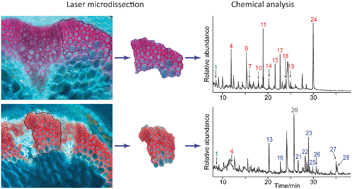The interest in renewable, plant-derived, bioenergy/biofuels has resulted in a renaissance of plant cell-wall/lignin research. Herein, effects of modulating lignin monomeric compositions in a single plant species, Arabidopsis, are described. The earliest stage of putative “AcBr/Klason lignin” deposition was apparently unaffected by modulating p-coumarate 3-hydroxylase or ferulate 5-hydroxylase activities. This finding helps account for the inability of many other studies to fully suppress the reported putative levels of lignin deposition through monolignol biosynthesis manipulation, and also underscores limitations in frequently used lignin analytical protocols. The overall putative lignin content was greatly reduced (circa 62%) in a plant line harboring an H-(p-hydroxyphenyl) enriched lignin phenotype. This slightly increased H-monomer deposition level apparently occurred in cell-wall domains normally harboring guaiacyl (G) and/or syringyl (S) lignin moieties. For G- and S-enriched lignin phenotypes, the overall lignification process appeared analogous to wild type, with only xylem fiber and interfascicular fiber cells forming the S-enriched lignins. Laser microscope dissection of vascular bundles and interfascicular fibers, followed by pyrolysis GC/MS, supported these findings. Some cell types, presumably metaxylem and possibly protoxylem, also afforded small amounts of benzodioxane (sub)structures due to limited substrate degeneracy (i.e. utilizing 5-hydroxyconiferyl alcohol rather than sinapyl alcohol). For all plant lines studied, the 8-O-4′ inter-unit frequency of cleavable H, G and/or S monomers was essentially invariant of monomeric composition for a given (putative) lignin content. These data again underscore the need for determination of lignin primary structures and identification of all proteins/enzymes involved in control of lignin polymer assembly/macromolecular configuration.

You have access to this article
 Please wait while we load your content...
Something went wrong. Try again?
Please wait while we load your content...
Something went wrong. Try again?


 Please wait while we load your content...
Please wait while we load your content...